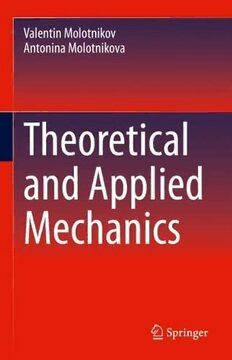Table Of ContentValentin Molotnikov
Antonina Molotnikova
Theoretical
and Applied
Mechanics
Theoretical and Applied Mechanics
Valentin Molotnikov • Antonina Molotnikova
Theoretical and Applied
Mechanics
ValentinMolotnikov AntoninaMolotnikova
DonStateTechnicalUniversity RostovInstitutefortheDefenseof
Rostov-on-Don,Russia EntrepreneurProtection
Rostov-on-don,Russia
ISBN978-3-031-09311-1 ISBN978-3-031-09312-8 (eBook)
https://doi.org/10.1007/978-3-031-09312-8
©TheEditor(s)(ifapplicable)andTheAuthor(s),underexclusivelicensetoSpringerNatureSwitzerland
AG2023
Thisworkissubjecttocopyright.AllrightsaresolelyandexclusivelylicensedbythePublisher,whether
thewholeorpartofthematerialisconcerned,specificallytherightsoftranslation,reprinting,reuse
ofillustrations,recitation,broadcasting,reproductiononmicrofilmsorinanyotherphysicalway,and
transmissionorinformationstorageandretrieval,electronicadaptation,computersoftware,orbysimilar
ordissimilarmethodologynowknownorhereafterdeveloped.
Theuseofgeneraldescriptivenames,registerednames,trademarks,servicemarks,etc.inthispublication
doesnotimply,evenintheabsenceofaspecificstatement,thatsuchnamesareexemptfromtherelevant
protectivelawsandregulationsandthereforefreeforgeneraluse.
Thepublisher,theauthors,andtheeditorsaresafetoassumethattheadviceandinformationinthisbook
arebelievedtobetrueandaccurateatthedateofpublication.Neitherthepublishernortheauthorsor
theeditorsgiveawarranty,expressedorimplied,withrespecttothematerialcontainedhereinorforany
errorsoromissionsthatmayhavebeenmade.Thepublisherremainsneutralwithregardtojurisdictional
claimsinpublishedmapsandinstitutionalaffiliations.
ThisSpringerimprintispublishedbytheregisteredcompanySpringerNatureSwitzerlandAG
Theregisteredcompanyaddressis:Gewerbestrasse11,6330Cham,Switzerland
DedicatedtotheblessedmemoryofBoris
AnisimovichBondarenko(1923–2017)—an
outstanding mathematicianandmechanic,a
talentedteacherandorganizerofscience,
DoctorofPhysicalandMathematical
Sciences,andacademicianoftheAcademyof
SciencesoftheRepublicofUzbekistan.
ValentinandAntonina
Abstract
The textbook outlines the fundamentals of theoretical and applied mechanics,
supplementedbyselectedsectionsfromthedevelopmentsofrecentdecades(drone
flight, car variators, etc.). The book is designed to be studied during one to two
semesters in the training of bachelors and masters in the direction of “Engi-
neering.” The course includes the main sections of the disciplines “Theoretical
Mechanics,” “Theory of Mechanisms and Machines,” “Strength of Materials,”
“Machine Parts and Design Fundamentals,” “Interchangeability, Standardization,
and Technical Measurements,” and “Introduction to CAD of based AutoCAD –
AutoLISP”. Such a representative set of disciplines allows the book to be used
by students of other technical and technology majors in each of these disciplines.
The conciseness makes the textbook a valuable aid in conditions of limited time
for the preparation of both during a semester and a session. In addition to being
concise, this differs from existing textbooks in its presentation of the state of the
artinmechanics,demonstrationofengineeringapplicationscomputerapplications
(MathCad,COSMOSWorks,Inkscape,AutoCAD,AutoLISP,etc.),presentationof
updateddataonengineeringmaterials-fromcompositestotheprospectsgraphene.
There are examples of designs of units in modern machines (combine harvester
“Don,”thecar“Infiniti”etc.),andalsothereisinformationaboutnationalstandards
in mechanical engineering. Examples are given of both simple and complex
engineeringcalculations.Attheendofeachchapterarequestionsforself-checking
andmultivariateproblemsforexercises.
vii
Acknowledgements
The authors express their gratitude to Doctor of Physical and Mathematical
Sciences,memberoftheRussianNationalCommitteeofIUTAMprof.L.M.Zubov
and prof. V. P. Zabrodin for selfless work on reviewing the manuscript. Special
thankstooursonZaur,whoinspiredustocreatethisbookforhishelpfuladviceon
book design and, as a native speaker, for taking on much of the communication
with Springer. We also thank Professor V. G. Malinin, Doctor of Physical and
MathematicalSciences,forhishelpintranslatingthisbookintoEnglish.
ix
Introduction
Modern scientific and technological progress and the rapid development of high
technologieshaveledtotheneedtoincludeinthecurriculaofeducationalinstitu-
tions many new disciplines,theknowledge of which isbecoming mandatory fora
modern specialist. Although the duration of training is limited, the modernization
of curricula inevitably leads to a reduction in the number of hours allocated for
thedevelopmentoffundamentalgeneraltechnicaldisciplines,includingtheoretical
and applied mechanics. The desire to preserve the completeness of the course,
and the rigor and clarity of the main provisions, combined with the clarity of the
presentationofthematerialandthedemonstrationofitsapplicationintechnology,
promptedtheauthorstowriteashortbutcompletetextbook.
The concentrated presentation of the course made it necessary to exclude from
consideration a number of issues traditionally presented in courses of theoretical
mechanics. Some of them seem to be utilitarian (e.g., graphostatics), while others
are applications of the main theorems of theoretical mechanics (fluctuations of a
materialpoint)anddonotcontainfundamentallynewmaterialcomparedtowhatis
studiedinschoolphysicscourses.
Atthesametime,tosolvemanyproblemsofmoderntechnology,sometimesthe
methodsofthetraditionalcourseoftheoreticalmechanicsarenotenough,anditis
necessary to use the general methods of analytical mechanics and control theory.
Inthisregard,theauthorconsidereditappropriatetomoveawayfromthetradition
andincludeinthebookmaterialonbothclassicalandthelatestvariationalmethods
of mechanics. And if the study of this material is still provided for only by a few
educationalstandardsformaster’sprograms,thenitcanbeusedinoptionalclasses.
In order not to overload the book with complex mathematical constructions,
when presenting this material, the authors deliberately never discussed the most
important question of the existence and uniqueness of solutions to the formulated
problems.
In recent decades, almost all over the world, a wave of reforms in the field
of education has unfolded. As a result, most higher education institutions were
transformedintouniversitiesandacademies.Thiscircumstanceobligestheauthors
oftextbookstoemphasizethestyleborderingonmonographic.Howfartheauthors
xi
xii Introduction
succeeded,thereaderscanjudge.Atthesametime,theauthorshaveretainedcertain
classicalelementsofthetextbook.Forexample,attheendofeachchapter,thereare
questionsforself-controlandmultivariatetasksforexercises.
Thebookisbasedonlecturesgivenbytheauthorsinrecentdecadesinindustrial,
military,andagriculturaluniversitiesoftheSovietUnionandRussia.
TheauthorsexpresstheirgratitudetotheCandidateofTechnicalSciences,assoc.
VeselovskyV.A.,whocarefullyreadthemanuscriptandmadeanumberofvaluable
commentsthatweretakenintoaccountinthefinalversionofthemanuscript.
Wearegratefulinadvancetoreaderswhowillsendfeedbackorsuggestionstoei-
theroftheemailaddresses:[email protected]@gmail.com.
Contents
PartI TheoreticalMechanics
1 Statics........................................................................ 3
1.1 Introduction........................................................... 3
1.2 TheSubjectandTasksofTheoreticalMechanics .................. 5
1.3 Strength.Forcesyste................................................. 6
1.4 AxiomsofTheoreticalMechanics................................... 8
1.5 ConnectionsandTheirReactions.................................... 10
1.5.1 ClassificationofConstraints.............................. 13
1.6 ConditionsfortheEquilibriumofConvergingForces.............. 14
1.7 ASystemofParallelForces:PowerPairs........................... 14
1.8 MomentofForceRelativetothePointandAxis................... 16
1.9 BasicTheoremofStatics ............................................ 20
1.10 EquilibriumofanArbitrarySystemofForces...................... 22
1.11 SolvingProblemsontheBalanceofSystemsofForces ........... 24
1.11.1 GeneralComment......................................... 24
1.11.2 Example1 ................................................. 25
1.11.3 Example2 ................................................. 26
1.11.4 Example3 ................................................. 28
1.12 TrussCalculation..................................................... 31
1.12.1 CalculationofaTriangularCantileverTruss ............ 33
1.12.2 CalculationofaSymmetricalBridgeGirder............. 36
1.13 ComputerCalculationofTruss...................................... 37
1.14 CenterofParallelForces............................................. 39
1.15 TheCenterofGravityofaRigidBody ............................. 41
Self-TestQuestions .......................................................... 43
References.................................................................... 52
2 Kinematics................................................................... 53
2.1 WaystoSettheMovement .......................................... 53
2.2 SpeedandAccelerationofthePoint ................................ 57
xiii

